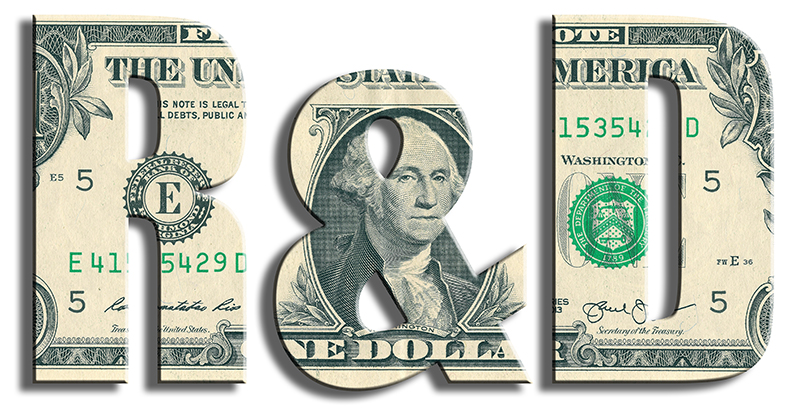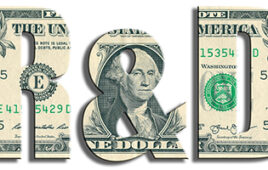 The R&D World Index (RDWI) for the week ending November 25, 2022, closed at 2,428.57 for the 25 companies in the RDWI. The Index was up 1.16% (or 27.79 basis points) from the week ending November 18, 2022. Twenty of the 25 RDWI members gained value during the past week from 0.03% (Alphabet/Google) to 3.75% (Oracle). Five of the 25 RDWI members lost value last week from -0.57% (Meta Platforms) to -6.19% (Alibaba).
The R&D World Index (RDWI) for the week ending November 25, 2022, closed at 2,428.57 for the 25 companies in the RDWI. The Index was up 1.16% (or 27.79 basis points) from the week ending November 18, 2022. Twenty of the 25 RDWI members gained value during the past week from 0.03% (Alphabet/Google) to 3.75% (Oracle). Five of the 25 RDWI members lost value last week from -0.57% (Meta Platforms) to -6.19% (Alibaba).
U.S. corporations are now required to write off their domestic R&D expenses over five years rather than deducting them right away like they did last year, according to a provision in the 2017 tax overhaul act. Nearly 180 corporate chief financial officers (CFOs) have warned that this R&D amortization over time could result in job losses, and they have requested a return to an immediate deduction. There is some democratic and republican haggling on this issue involving trade-offs with child tax credits, short-lived asset write-offs, and bonus depreciation among others. Analysts at Evercore ISI don’t expect a resolution in the current lame-duck session, since there are so many other priorities to be dealt with, such as inflation and rising government debt levels and policymakers are wary of passing costly end-of-year policy changes.
RDW Index member Merck & Co., Kenilworth, New Jersey, announced last week that it has agreed to buy blood-cancer biotech firm Imago BioSciences Inc., Redwood City, California, for $1.35 billion. Imago is developing drugs to treat bone-marrow diseases. Merck is also said to be in advanced talks to buy cancer-drug biotech Seagen, Bothell. Washington. Big pharma cos, like Merck, continue to look for acquisitions that can provide faster sales growth after shedding slower-growing assets. Merck purchased cell growth biotech Acceleron Pharma, Cambridge, Massachusetts, in late 2021 for about $12 billion.
Computer maker HP Inc., Palo Alto, California, announced last week that it would cut up to 10% of its staff of roughly 61,000 employees as part of a transformation plan to achieve $1.4 billion in annual cost savings. The company does not expect the current economic downturn will change in 2023. HP invested about $1 billion in R&D in 2020. The company cited changing consumer spending habits, continuing supply-chain constraints, higher interest rates, and a stronger U.S. dollar as contributing factors in their decision. These issues are also affecting the operations are Dell Technologies, Intel, and Advanced Micro Devices (AMD). RDW Index member Apple appears to be weathering this economic slowdown better than others, reporting record revenues in their latest quarterly report.
Audiovisual firm Kramer, Tel Aviv, Israel, announced last week that it had opened a new R&D center in Noida, India, which is an extension of its global R&D organization in Israel and Canada. The Indian center is intended to drive the development of applications and software solutions in the UCC (uniform commercial code) space and other software-centric areas.
Wuxi STA Pharmaceutical, Changzhou, China, last week announced the groundbreaking for its Wuxi STA Pharmaceutical East China R&D facility in the Changzhou National High Tech District. The new R&D facility will invest in state-of-the-art instrumentation and equipment to support its planned recruitment of more than 3,000 pharmaceutical researchers and developers.
The U.S.-global trade picture continues to change with the U.S. importing more goods from Europe than from China in recent months according to new data from the U.S. Department of Commerce (DOC). These events are helping embattled European manufacturers who are fighting surging energy prices. It’s also increasing the container volumes on the U.S. east coast ahead of their west coast counterparts. Germany’s exports to the U.S. rose by nearly 50% in September 2022 over 2021 and the weak Euro is giving European manufacturers an extra edge in the vast U.S. marketplace. European manufacturers are also investing in the U.S. and Mexico to build manufacturing facilities to take advantage of cheap energy prices and easy access to the vast North American marketplace.
The Organization for Economic Cooperation and Development (OECD), Paris, France, reported last week that the European Central Bank (ECB), Frankfurt, Germany, will have to raise its key interest rate much further if it is to bring down persistently high inflation. The OECD said the ECB should raise its key interest rate to between 4% and 4.25% from its current 1.5% by the middle of 2023. The Eurozone’s inflation rate is expected to average 6.8% in 2023, up from a previously forecast 6.2%. A high rate is needed to support the euro’s exchange rate against the U.S. dollar and prevent larger price increases.
A report in the Wall Street Journal last week noted that overhiring at mega U.S. companies at the start of the COVID-19 pandemic is now resulting in large layoffs by the same companies, including Meta Platforms, Netflix, and Electronic Arts. Labor demand, however, still remains relatively high, especially in those areas not represented by the notorious high-tech companies. Job openings as a share of filled and unfilled positions continue at an all-time high in the leisure and hospital sectors of the economy.
The Central Intelligence Agency (CIA), Washington, D.C., reported last week that it is now recruiting agents from Russia among disgruntled military officers, oligarchs whose fortunes have waned, and businesspeople and others who have fled the country. Possibly some of those might also include R&D specialists in various disciplines.
R&D World’s R&D Index is a weekly stock market summary of the top international companies involved in R&D. The top 25 industrial R&D spenders in 2020 were selected based on the latest listings from Schonfeld & Associates’ June 2020 R&D Ratios & Budgets. These 25 companies include pharmaceutical (10 companies), automotive (6 companies) and ICT (9 companies) who invested a cumulative total of nearly 260 billion dollars in R&D in 2019, or approximately 10% of all the R&D spent in the world by government, industries and academia combined, according to R&D World’s 2021 Global R&D Funding Forecast. The stock prices used in the R&D World Index are tabulated from NASDAQ, NYSE, and OTC common stock prices for the companies selected at the close of stock trading business on the Friday preceding the online publication of the R&D World Index



Tell Us What You Think!